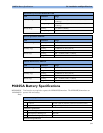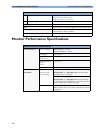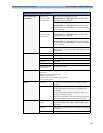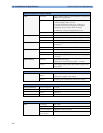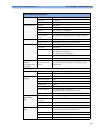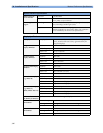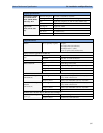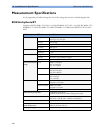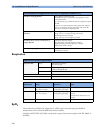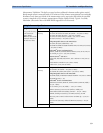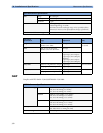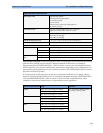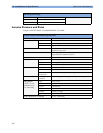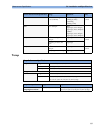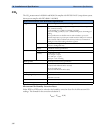
Measurement Specifications 34 Installation and Specifications
349
ECG/Arrhythmia/ST Alarm
Specifications
Range Adjustment
HR 15 to 300 bpm
maximum delay: 10 seconds according
to AAMI EC 13-1992 standard
Adult:1 bpm steps (15 to 40 bpm)
5 bpm steps (40 to 300 bpm)
Pedi/Neo:1 bpm steps (15 to 50 bpm)
5 bpm steps (50 to 300 bpm)
Extreme Tachy Difference to high limit 0 to 50 bpm 5 bpm steps
Clamping at 150 to 300 bpm
5 bpm steps
Extreme Brady Difference to low limit 0 to 50 bpm 5 bpm steps
Clamping at 15 to 100 bpm
5 bpm steps
Run PVCs 2 PVCs Not adjustable by user
PVCs Rate 1 to 99 PVCs/minute 1 PVC
Vent Tach HR 20 to 300 bpm 5 bpm
Vent Tach Run 3 to 99 PVCs/minute 1 PVC
Vent Rhythm Run 2 to 99 PVCs/minute 1 PVC
SVT HR 120 to 300 bpm 5 bpm
SVT Run 3 to 99 SV beats 1 SV beat
ST High -19.8 to +20 mm 0.2 mm
ST Low -20 to +19.8 mm 0.2 mm
ECG/Arrhythmia/ST Supplemental Information as required by AAMI EC11/13
Respiration Excitation Waveform Sinusoidal signal, 260 µA, 39 kHz
Noise Suppression RL drive gain 44 dB max., max. voltage 1.8 Vrms
Time to Alarm for
Tachycardia
Vent Tachycardia
1mV
pp
,206 bpm
Gain 0.5, Range 6.5 to 8.4 seconds, Average 7.2 seconds
Gain 1.0 Range 6.1 to 6.9 seconds, Average 6.5 seconds
Gain 2.0, Range 5.9 to 6.7 seconds, Average 6.3 seconds
Vent Tachycardia
2 mV
pp
,195bpm
Gain 0.5, Range 5.4 to 6.2 seconds, Average 5.8 seconds
Gain 1.0, Range 5.7 to 6.5 seconds, Average 6.1 seconds
Gain 2.0, Range 5.3 to 6.1 seconds, Average 5.7 seconds
Tall T-Wave Rejection Capability Exceeds ANSI/AAMI EC 13 Sect. 3.1.2.1(c)
minimum recommended 1.2 mV T-Wave amplitude



